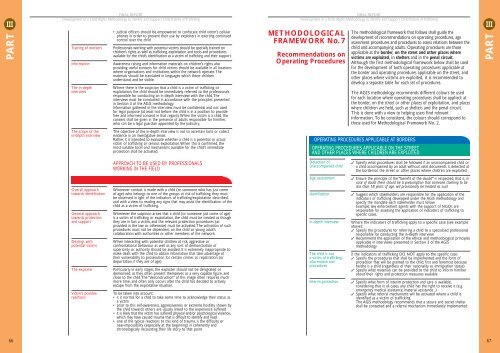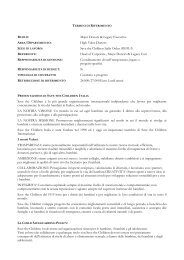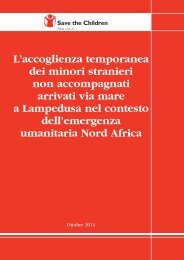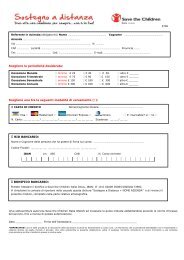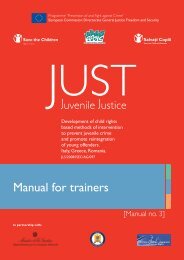FINAL REPORT - Save the Children Italia Onlus
FINAL REPORT - Save the Children Italia Onlus
FINAL REPORT - Save the Children Italia Onlus
You also want an ePaper? Increase the reach of your titles
YUMPU automatically turns print PDFs into web optimized ePapers that Google loves.
IIIPART<strong>FINAL</strong> <strong>REPORT</strong>Development of a Child Rights Methodology to Identify and Support Child Victims of TraffickingTraining of workersInformationThe in-depthinterview• Judicial officers should be empowered to confiscate child victim’s cellularphones in order to prevent <strong>the</strong>ir use by exploiters in exerting continuedcontrol over <strong>the</strong> childProfessionals working with potential victims should be specially trained onchildren’s rights, as well as trafficking, exploitation and tools and proceduresavailable for <strong>the</strong> child’s identification as a victim of trafficking and <strong>the</strong>ir support.Awareness raising and information materials on children’s rights alsoproviding useful contacts for child victims should be available in all locationswhere organisations and institutions within <strong>the</strong> network operate.Thematerials should be translated in languages which those childrenunderstand, and be visible.Where <strong>the</strong>re is <strong>the</strong> suspicion that a child is a victim of trafficking orexploitation, <strong>the</strong> child should be immediately referred to <strong>the</strong> professionalsresponsible for conducting an in-depth interview with <strong>the</strong> child.Theinterview must be conducted in accordance with <strong>the</strong> principles presentedin Section 3 of <strong>the</strong> AGIS methodology.Information ga<strong>the</strong>red in <strong>the</strong> interview must be confidential and not usedfor legal purpose (at least not before <strong>the</strong> child is in a position to providefree and informed consent in that regard). When <strong>the</strong> victim is a child, <strong>the</strong>consent shall be given in <strong>the</strong> presence of adults responsible for him/her,who can be a legal guardian appointed by <strong>the</strong> Judiciary.<strong>FINAL</strong> <strong>REPORT</strong>Development of a Child Rights Methodology to Identify and Support Child Victims of TraffickingMETHODOLOGICALFRAMEWORK No. 7Recommendations onOperating ProceduresThe methodological framework that follows shall guide <strong>the</strong>development of recommendations on operating procedures, ageassessment procedures and procedures to assess relations between <strong>the</strong>child and accompanying adults. Operating procedures are thoseapplicable at <strong>the</strong> border, on <strong>the</strong> street and o<strong>the</strong>r places wherevictims are exploited, in shelters and in <strong>the</strong> penal circuit.Although <strong>the</strong> first methodological framework below shall be usedfor <strong>the</strong> development of both operating procedures applicable at<strong>the</strong> border and operating procedures applicable on <strong>the</strong> street, ando<strong>the</strong>r places where victims are exploited, it is recommended todevelop a separate table for each set of procedures.The AGIS methodology recommends different colours be usedfor each location where operating procedures shall be applied: at<strong>the</strong> border, on <strong>the</strong> street or o<strong>the</strong>r places of exploitation, and placeswhere children are held, such as shelters and <strong>the</strong> penal circuit.This is done with a view to helping users find relevantinformation. To be consistent, <strong>the</strong> colours should correspond tothose used for Methodological Framework No. 2.IIIPARTThe scope of <strong>the</strong>in-depth interviewThe objective of <strong>the</strong> in-depth interview is not to ascertain facts or collectevidence in an investigative sense.Ra<strong>the</strong>r, it is intended to evaluate whe<strong>the</strong>r a child is a potential or actualvictim of trafficking or serious exploitation. When this is confirmed, <strong>the</strong>most suitable tools and mechanisms available for <strong>the</strong> child’s immediateprotection shall be activated.OPERATING PROCEDURES APPLICABLE AT BORDERSOPERATING PROCEDURES APPLICABLE ON THE STREETAND OTHER PLACES WHERE CHILDREN ARE EXPLOITEDAPPROACH TO BE USED BY PROFESSIONALSWORKING IN THE FIELDDetection ofunaccompanied child✓ Specify what procedures shall be followed if an unaccompanied child ora child accompanied by an adult without valid documents is detected at<strong>the</strong> border/on <strong>the</strong> street or o<strong>the</strong>r places where children are exploitedOverall approachtowards identificationGeneral approachtowards protectionand supportDealings withpotential victimsThe exploiterVictim’s possiblereactionsWhenever contact is made with a child (or someone who has just comeof age) who belongs to one of <strong>the</strong> groups at risk of trafficking, <strong>the</strong>y mustbe observed in light of <strong>the</strong> indicators of trafficking/exploitation described,and with a view to reading any signs that may assist <strong>the</strong> identification of <strong>the</strong>child as a victim of trafficking.Whenever <strong>the</strong> suspicion arises that a child (or someone just come of age)is a victim of trafficking or exploitation, <strong>the</strong> child must be treated as though<strong>the</strong>y are in fact a victim, and <strong>the</strong> relevant protection procedures (asprovided in <strong>the</strong> law or o<strong>the</strong>rwise) must be activated.The activation of suchprocedures must not be dependent on <strong>the</strong> child or young adult’scollaboration with authorities or o<strong>the</strong>r members of <strong>the</strong> network.When interacting with potential children at risk, aggressive orconfrontational behaviour as well as any sort of demonstration ofsuperiority or authority should be avoided. It is extremely inappropriate tomake deals with <strong>the</strong> child to obtain information that take advantage of<strong>the</strong>ir vulnerability to prosecution for certain crimes or repatriation (ordeportation, if <strong>the</strong>y are of age).Particularly in early stages, <strong>the</strong> exploiter should not be denigrated ordemonised, as <strong>the</strong>y often present <strong>the</strong>mselves as a very capable figure, andclose to <strong>the</strong> child.The “deconstruction” of this image often requires muchmore time, and often only occurs after <strong>the</strong> child has decided to activelyescape from <strong>the</strong> exploitative situation.To be taken into account:• it is normal for a child to take some time to acknowledge <strong>the</strong>ir status asa victim• prior to this self-awareness, aggressiveness or extreme hostility shown by<strong>the</strong> child towards o<strong>the</strong>rs are usually linked to <strong>the</strong> experience suffered• it is likely that <strong>the</strong> victim has suffered physical and/or psychological violence,which may have caused trauma that is difficult to identify and read• one of <strong>the</strong> typical reactions to this kind of trauma, is <strong>the</strong> difficulty ornear-impossibility (especially at <strong>the</strong> beginning) in coherently andchronologically recounting <strong>the</strong>ir life story to that pointAge assessmentIdentificationIn-depth interviewThe child is nota victim of trafficking:Information andproceduresInterim protection✓ Ensure <strong>the</strong> principle of <strong>the</strong> “benefit of <strong>the</strong> doubt” is respected, that is, incase of doubt <strong>the</strong>re should be a presumption that someone claiming to beless than 18 years of age, will provisionally be treated as such✓ Suggest which stakeholders are responsible for <strong>the</strong> application of <strong>the</strong>indicators of trafficking developed under <strong>the</strong> AGIS methodology andspecify <strong>the</strong> mandate each stakeholder must followExample: law enforcement agents with <strong>the</strong> support of NGOs areresponsible for assessing <strong>the</strong> application of indicators of trafficking tospecific cases.Where <strong>the</strong> indicators of trafficking apply to a specific case (see exampleabove):✓ Specify <strong>the</strong> procedures for referring a child to a specialised professionalresponsible for conducting <strong>the</strong> in-depth interview✓ Recommend <strong>the</strong> application of <strong>the</strong> ethical and methodological principlesapplicable in interviews presented in Section 3 of <strong>the</strong> AGISmethodologyIf <strong>the</strong> indicators of trafficking DO NOT apply to <strong>the</strong> specific case:✓ Specify <strong>the</strong> procedures that shall be implemented and <strong>the</strong> form ofprotection that will be granted to <strong>the</strong> child, first and foremost becausehe/she is a child (regardless of <strong>the</strong>ir nationality or immigration status)✓ Specify what materials can be provided to <strong>the</strong> child to inform him/herabout <strong>the</strong>ir rights and protection measures available✓ Specify what form of interim protection and care is available,considering that in all cases, any child has <strong>the</strong> right to receive it (e.g.emergency medical assistance, material assistance...)✓ Specify what referral mechanisms will be activated where a child isidentified as a victim of traffickingThe AGIS methodology recommends that a secure and secret sheltershall be contacted and a referral mechanism immediately implemented.6667


